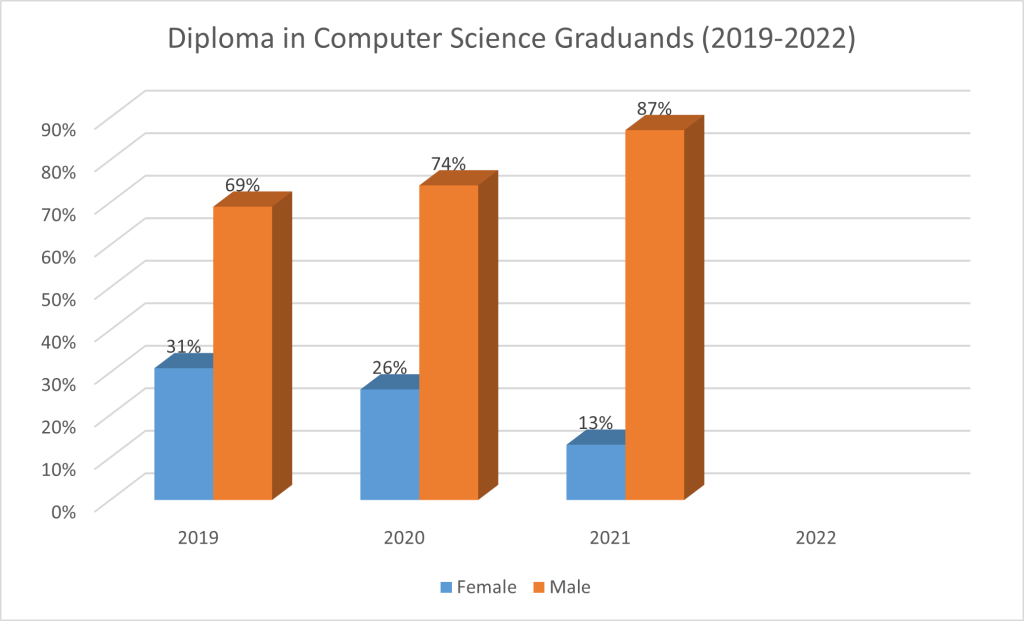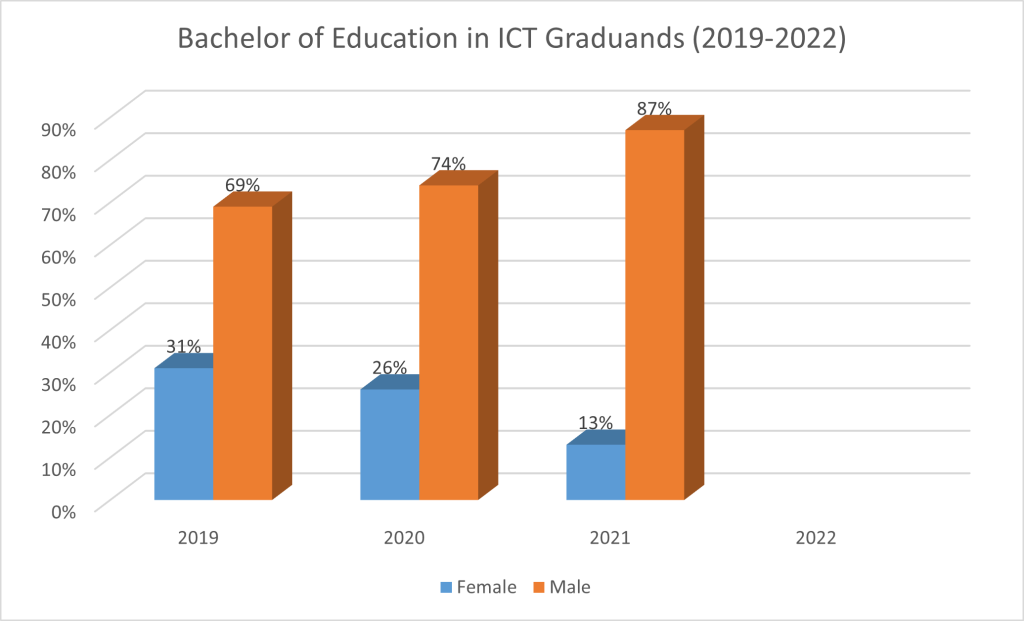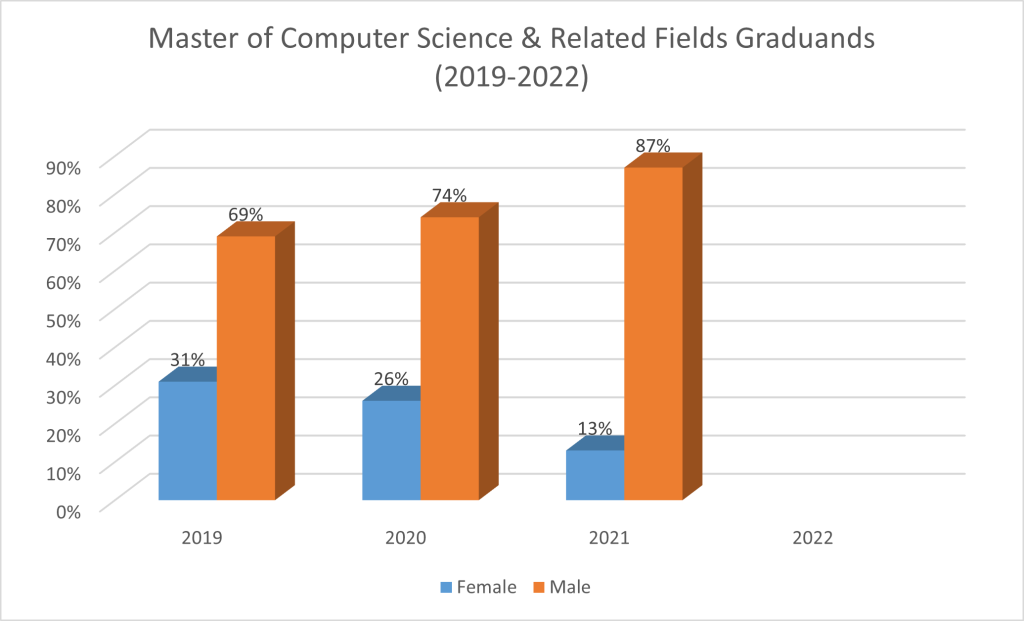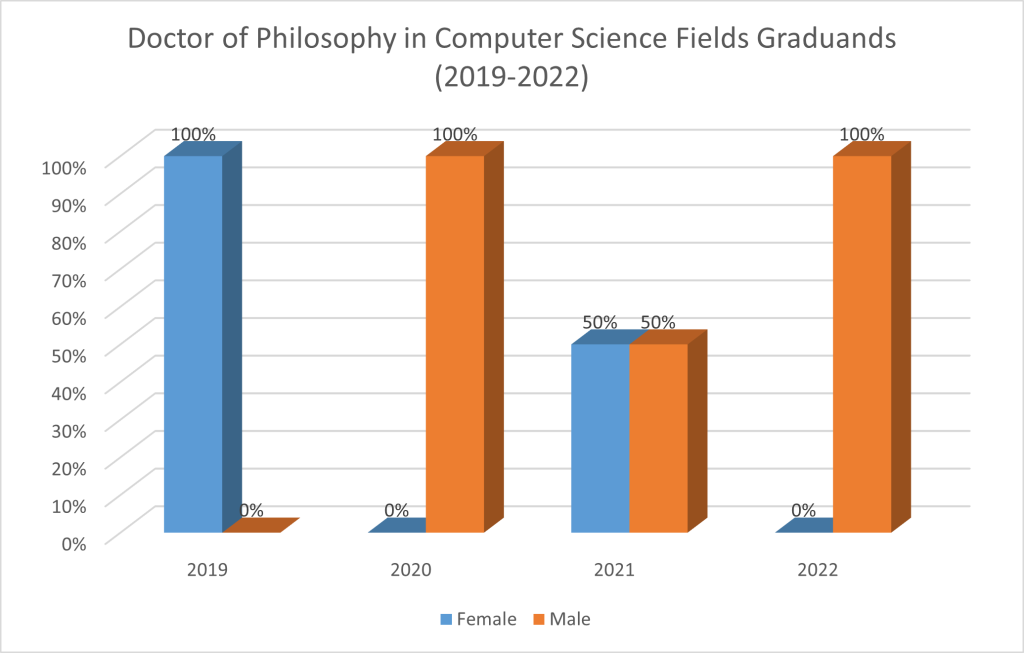Women and Technology in Higher Education, A Case Study of the University of Nairobi, Faculty of Science and Technology
- Agunda, Monica A
- Ngesu, Lewis N
- Kalai, Jeremiah M
- 1371-1378
- Jun 22, 2024
- Education
Women and Technology in Higher Education, A Case Study of the University of Nairobi, Faculty of Science and Technology
Agunda, Monica A1, Ngesu, Lewis N2. and Kalai, Jeremiah M3.
Department of Educational Foundations (online), University of Nairobi.
DOI: https://dx.doi.org/10.47772/IJRISS.2024.803095S
Received: 27 April 2024; Revised: 15 May 2024; Accepted: 20 May 2024; Published: 22 June 2024
ABSTRACT
The general objective of the study was to establish and report on the number of women graduating in Computer Science and related fields and make recommendations for policy reviews and further research. The University of Nairobi, Faculty of Science and Technology was used as a case study. The study used descriptive research survey design. A census was undertaken for every year (2019 to 2022). Data was collected by studying historical data on graduation outputs (61st to 68th graduations) in Computer Science and related disciplines in the last four years. Data was analyzed using percentages captured through Microsoft Excel, and the results presented in tables. Reliability was tested using data source evaluation (verification of the graduation booklets obtained from the Academic Registrar’s office) and content validity was employed. The study found that, out of the 696 graduands in the last four years, only 166 (24%) were females against 530 (76%) males. This study recommends further research by stakeholders in education in order to understand the reasons behind this worrying phenomenon and further recommend mitigation measures from forums such as African Women Study Centre and Women’s Economic Empowerment Hub, to inform policy.
INTRODUCTION
Technology is about more than gadgets, and means different things to different people. The role and impact of technology in both our personal and working lives is forever growing. The significance of comprehending the reciprocal influence between individuals and technology is emphasized by La Shun & Carrol (2017) who highlight its relevance not only for those engaged in research, technological, development, and implementation, but also for individuals as well as organizations incorporating technology into their professional and personal spheres. A report by MacLaunglin, Supemaw & Howard (2018) states that the rate of technological advancement is rapid and many institutions are integrating the concept of technology in their courses. They (MacLaunglin, et.al., 2021) observe that the interaction of computers in educational institutions enables immediate access to electronic resources provided by diverse resource providers.
The World Bank EdTech Approach Paper (2020) refers to the Educational Technology (EdTech’) as the use of hardware, software, digital content, data, and information systems in education to support and enrich teaching and learning as well as improving management of education and service delivery. The report adds that technology should be used to enhance teacher engagement with students through improved access to content, data and networking, which helps teachers to better support students learning.
Higher education refers to the level of learning that occurs beyond secondary education, typically at colleges, universities, and other post-secondary institutions. It encompasses various degree programs, including undergraduate, graduate, and professional studies. In the Kenyan education system, the update of digital courses and are availed as elective subjects at secondary school level.
Studies by (Botella, Rueda, López-Iñesta, & Marzal, 2019; Gomez, Abadía Alvarado, & Bernal Nisperuza, 2020; Quirós et al., 2018; UNESCO 2009–2017; Wang & Degol, 2017; World Economic Forum, 2016), reveal that the gender gap is a major challenge in all sectors of the society, but is especially visible in STEM, both in educational and professional contexts. The mean percentage of female students in tertiary education enrolled in engineering, manufacturing and construction programs ranged between 6% and 7% from 2015 to 2018; in contrast, the percentage of male students choosing these careers was around 20–21% (UNESCO Institute for Statistics 2018). Other studies/reports have also confirmed that women are persistently underrepresented in STEM (Directorate-General for Research and Innovation Horizon, 2020; OECD, 2015; Tomassini, 2021; UNESCO, 2007; UNESCO Institute for Statistics, 2018). Although most countries have more women than men enrolled in tertiary education, the number of women in tertiary education who choose STEM is around 15% (UNESCO. Director-General 2009–2017).
Statement of the Problem
Higher Education HEIs) play a significant role in advancing the Sustainable Development Goals (SDGs) both through their internal policies, and by equipping students with necessary skills to address the 21st Century challenges. The 4th goal of SDGs emphasizes on gender equality through provision of inclusive high-quality education for all. Studies confirm that increasing the number of women in digital jobs would increase the Gross Domestic Product – making it an economic booster. However, the gender disparity on women and technology in higher education remains a challenge.
According to Barasa (2021), Kenya has a number of policies that aim at encouraging more school-going children to embrace courses that would lead them to a digital career. However, these initiatives seem to have done very little to bridge the gender divide in digital technology careers in Kenya (OECD, 2018). The various initiatives that were put in place have faced an array of challenges of inadequate infrastructure. Barasa (2021) adds that a digital divide between rural and urban areas also continue to worsen existing education inequalities. While digital technology careers are highly advertised as the jobs of the future, women occupy less than 30% of digital technology positions in Kenya.
Despite advancements in women’s societal roles over the past five decades, the gender pay disparity persists. While a significant portion of this gap can be attributed to differing career choices between men and women, Blau & Kahn (2017) lament that the motivations behind these choices remain unclear. A field (UNESCO Report, 2017) indicate that only 19% of all Computer Science degrees are obtained by women, but the report does not give a breakdown, and is also more than five years old. It would be important to find the current status.
The reviewed literature on women and technology provide both contextual and conceptual gaps with various studies done globally, regionally and locally at the National level. In addition, the reviewed literature looked at women and technology in STEM. This study attempted to bridge the knowledge gap in literature by analyzing graduation outputs to find out the number of women graduating with computer science and related fields using the University of Nairobi, Faculty of Science and Technology as a case study.
Objectives of the study
The general objective of the study was to find out and report on the number of women graduating in Computer Science and related disciplines and make recommendations for policy.
LITERATURE REVIEW
Christie, O’Neill, Rutter, & Young (2017), carried out a study to establish why very few women enrolled in STEM subjects. The study also investigated ways of increasing women’s recruitment and retention in this area. The informants in the study were enrolled in a tertiary preparation course as well as nursing and education programs. A critique of the literature was used to develop a survey which informed focus group and interview schedules used in collecting data. The study found that many of the factors that hindered women from applying for STEM courses twenty years ago still apply currently. The study recommended that actions which could help increase recruitment of women into STEM and assist their retention and graduation in those areas of tertiary education be implemented. The researchers reported that in addition to the comparatively low participation rates of women in STEM, their attrition rates are also high. An obvious solution is to attract more women to study such subjects.
Another study by Luvanda (2023), took a qualitative approach in trying to identify the root causes for the exclusion of girls and young women from digital technology courses at all levels of education – namely lower primary, upper primary, junior high school, senior high school, and the tertiary level in both rural and urban communities. The study identified various cumulative factors that contribute to fewer women taking up digital technology courses, such as: inadequate infrastructure; insufficient staffing and training of digital technology personnel at learning institutions; the negative impact of gendered social norms; poor advocacy of digital technology careers; the absence of vocational counselling; and the lack of women role models. The study recommended that an increase in the number of women in digital technology careers would be achieved by improving institutional digital technology infrastructure at all levels of education, enhancing the training of digital technology personnel within all levels of education, building girls’ interest in digital technology-related courses from the earliest years, increasing digital technology advocacy and awareness among girls, and enhancing vocational counselling on digital technology careers.
In a related study by Mercader & Duran-Bellonch (2021), on the reality of unequal status of female teachers in higher education posed a question ‘Are digital technologies another reason for their exclusion? The main aim of the study was to analyze the integration of digital technologies in teaching from a gender perspective. The research was a multiple case study applying the quantitative method. The sample comprised 527 teachers from four Spanish universities. The instrument utilized was a self-administered survey. The results confirm both types of segregation and the fact that female teachers see themselves as less digitally competent than their male counterparts. Ironically, the findings also showed that female teachers used Information and Communication Technologies in teaching more than the male teachers. In conclusion, the researchers highlighted the need to study more deeply the intersection between digital breach and gender in higher education, and to take measures during the early stages of education to overcome female teachers’ tendency of underestimating their digital competence.
In their analysis of the retention of women in higher education STEM programs, (Ortiz-Martínez, et al., 2023) looked at gender, equity and quality education as Sustainable Development Goals (SDG) that are present when a culture of equity and inclusion is pursued in society, companies, and institutions. Particularly in undergraduate programs in Science, Technology, Engineering, and Mathematics (STEM), there is a noticeable gender gap between men and women. The objective of the study was to establish the cause longevity in STEM careers by women, as well as the possible causes of career abandonment towards another STEM or non-STEM career. This was done by analyzing historical data for admission to STEM careers and using an instrument (survey) for data collection carried out in a private university in Mexico. Historical data indicated that only 17% of the total population were women choosing a STEM career. A survey was carried out for 3 months to obtain information on the factors that affect the decision to opt for a STEM career or to remain in it. It was found that men and women prefer inspiring Faculty who motivate them to continue their careers. Factors such as the competitive environment and the difficulty of teaching with less empathetic Faculty were negative and decisive aspects of decision-making. School achievement did not influence the dropout rate of women in STEM careers. The factors of choice and desertion of women in STEM careers were determined, and actions of educational innovation such as mentoring and timely monitoring of already enrolled female students, digital platforms for students and Faculty, awareness workshops for Faculty, and talks with successful women in STEM areas were proposed.
A report by the Organization for Economic Co-operation and Development (OECD, 2018) on ‘Bridging the Digital Gender Divide’ states that the road ahead is uphill: That today worldwide some 327 million fewer women than men have smart phones and can access the mobile internet. Women are under-represented in ICT jobs, top management and academic careers as shown in the report which states that men are four times more likely than women to be ICT specialists. At 15 years of age, on average, only 0.5% of girls wish to become ICT professionals, compared to 5% of boys. Women-owned start-ups receive 23% less funding and are 30% less likely to have a positive exit compared to male-owned businesses. The report indicates that hurdles to access, affordability, lack of education as well as inherent biases and socio-cultural norms curtail women and girls’ ability to benefit from the opportunities offered by the digital transformation. In addition, girls’ relatively lower educational enrolment in disciplines that would allow them to perform well in a digital world – such as Science, Technology, Engineering and Mathematics, as well as Information and Communication Technologies – coupled with women’s and girls’ more limited use of digital tools could lead to the widening gaps and greater inequality.
METHODOLOGY
The study used descriptive research survey design. A census was undertaken for every year (2019 to 2022). The University of Nairobi was chosen through purposive sampling by virtue of being the oldest public university in Kenya. Quantitative data was collected by studying historical data on graduation outputs (61st to 68th graduations) in Computer Science and related fields in the last four years. The data collected was analyzed using percentages captured through Microsoft Excel, and the results presented in tables. Reliability was tested using data source evaluation (verification of the graduation booklets obtained from the Academic Registrar’s office) and content validity was employed.
FINDINGS AND DISCUSSIONS
Data was collected by studying historical data on graduation outputs in Computer Science and related disciplines in the last four years (2019 to 2022) which were the University of Nairobi 61st to 68th graduations. The findings are presented in Table 1 and Figures 1.1 to 1.6 below:
Table 1: Analysis of Graduation output in Computer Science and related Fields from 2019-2022.
| Diploma | BSc | BED ICT | Masters | PHD | |||||||
| S/No. | Year | Female | Male | Female | Male | Female | Male | Female | Male | Female | Male |
| 61 | 2019 | 8 | 18 | 8 | 36 | 2 | 17 | 17 | 35 | 2 | 0 |
| 63 & 64 | 2020 | 16 | 45 | 13 | 64 | 3 | 14 | 17 | 40 | 0 | 2 |
| 65 & 66 | 2021 | 2 | 13 | 17 | 48 | 11 | 25 | 20 | 57 | 2 | 2 |
| 67 & 68 | 2022 | 9 | 57 | 7 | 23 | 12 | 30 | 0 | 4 | ||
| 26 | 76 | 47 | 205 | 23 | 79 | 66 | 162 | 4 | 8 | ||
Fig. 1.1 Diploma in Computer Science Graduands (2019-2022)
Fig. 1.2 Bachelor of Science in Computer Science Graduands (2019-2022)
Fig. 1.3 Bachelor of Education, ICT Graduands (2019-2022)
Fig. 1.4 Master of Computer Science & Related Fields Graduands (2019-2022)
Fig. 1.5 Doctor of Philosophy in Computer Science & Related Fields Graduands (2019-2022)
According to the results in Table 1 and Figures 1.1 to 1.6 above, the University of Nairobi has graduated a total of 696 students in Computer Science and related fields. Out of the 696 graduands, only 166 (24%) were females against 530 (76%) males in the last four years (from 2019 to 2022). These research findings are in agreement with other researchers such as Luvanda, 2023 and Mercader & Duran-Bellonch (2021). These findings are also in tandem with UNESCO Report (2017) which indicates that only 19% of all Computer Science degrees are obtained by women. The findings which show the gender parity in STEM are also in concurrence with the findings of Christie, O’Neill, Rutter, & Young (2017) and (Ortiz-Martínez, et al., 2023).
CONCLUSIONS
For HEIs to successfully contribute to the SDGs, there is need to focus on the 4th goal of the SDGs centres on gender equality through provision of inclusive high quality education and fostering lifelong learning opportunities for everyone. There is convergence in literature and analysed data that the gender gap is real in higher education and requires urgent attention in terms of policy, and paradigm shift in education. The traditional perspective of women as taking the second place after men seems to have a bearing on women’s role in higher education. The influence of culture, coupled with majority of women’s self-conviction about their inability to pursue digital related courses have cost them opportunities to pursue such courses that would have definitely changed their career progression.
For HEIs to successfully contribute to the SDGs, there is need to focus on the 4th goal of the SDGs which centres on gender equality through provision of inclusive high-quality education and fostering lifelong learning opportunities for everyone. There is convergence in literature and analysed data that the gender gap is real in higher education and requires urgent attention in terms of policy, and paradigm shift in education. The traditional perspective of women as taking the second place after men seems to have a bearing on women’s role in higher education. The influence of culture, coupled with majority of women’s self-conviction about their inability to pursue digital related courses have cost them opportunities to pursue such courses that would have definitely changed their career progression.
Further, it is clear from the data analysis that the output in terms of the graduands is minimal (24%) compared to the market demand. This may require Universities to review their programs and entry requirements to attract more female students in order to bridge the gender gap in the market. Increased training and re-training of females in technology, sensitization of women in technology on relevance of digital education would play a vital role in enhancing their visibility not only in Kenya, but also at global level.
RECOMMENDATIONS
The study makes recommendations for further research on women and technology in higher education using multifaceted approach that considers various factors such as access to technology, participation rates, attitudes towards technology, and the impact of the technology on learning outcomes and career trajectories.
This study recommends further research by various stakeholders in education in order to understand the reasons behind this worrying phenomenon and recommend mitigation measures from forums such as African Women Study Centre and Women’s Economic Empowerment Hub, to inform policy.
REFERENCES
- Barasa, P. (2021). Digitalization in teaching and education in Kenya: Digitalization, the future of work and the teaching profession. Geneva: International Labour Organization.
- Blau, F. D., & Kahn, L. M. (2017). The Gender Wage Gap: Extent, Trends, and Explanations. Journal of Economic Literature, 55(3): 789–865.
- Christie, M., O’Neill, M., Rutter, K., & Young. (2017). Understanding why women are under-represented in Science, Technology, Engineering and Mathematics (STEM) within Higher Education: a regional case study. Production,. 27(spe), e20162205; http://dx.doi.org/10.1590/0103-6513.220516.
- Development, O. f.-o. (2018). Bridging the digital gender divide include, upskill, innovate. https://www.oecd.org/digital/bridging-the-digital-genderdivide.pdf.
- Luvanda, A. (2023). A policy framework for Bridging the Divide in Digital Technology Courses and Careers in Kenya. . Nairobi, Kenya: ECHIDNA GLOBAL SCHOLARS PROGRAM.
- Mercader, C., & Duran-Bellonch , M. (2021). Female Higher Education teachers use Digital Technologies more and better than they think. . Digital Education Review – Number 40,.
- Ortiz-Martínez, G., Vázquez-Villegas, P., Ruiz-Cantisani, M. I., Delgado-Fabián, M., Conejo-Márquez, D. A., & Membrillo-Hernánde, J. (2023). Analysis of the retention of women in higher education STEM programs. . Humanities & Social Science Communication, https://doi.org/10.1057/s415.
- UNESCO. (2017). Cracking the code: Girls’ and women’s education in science, technology, engineering and mathematics. https:// unesdoc.unesco.org/ark:/48223/pf0000253479.





